A Study of Evaluation Method for Turbocharger Turbine Based on Joint Operation Curve
Abstract
:1. Introduction
2. Materials and Methods
2.1. Research Methodology and Research Objects
2.2. Setting Model Parameters
2.3. Test Preparation
2.4. Model Validation
3. Results
3.1. Coupling of Internal Joint Operating Curves
- Speed balance: the compressor, turbine, and rotor shaft have the same speed.where is the compressor speed (rpm), is the turbine speed (rpm), and is the rotor shaft speed (rpm);
- Flow rate balance: the compressor working mass flow rate plus the engine fuel mass flow rate is equal to the turbine working mass flow rate, and this flow rate balance condition is also followed when the turbine bypass valve is opened.where is the turbine operating flow rate (kg/s), is the compressor operating flow rate (kg/s), and is the fuel flow rate (kg/s);
- Power balance: The power transfer from the turbine side to the compressor side will lose part of the power, which includes turbine rotor lubrication and cooling losses, as well as the heat radiation of the components and other losses. The turbine power output minus this loss is equal to the compressor power consumption.where is the turbine output power (kW), is the compressor power consumption (kW), and is the power loss during energy transfer (kW).
3.2. Turbine Optimization Evaluation Method
3.3. Analysis of Turbine Impeller Blade Number Based on Joint Point
3.4. Comparative Analysis of Engine Performance with Optimized Structure of Two Methods
- The working fluid is a uniform state, and the air entering the cylinder and the residual exhaust gas are completely mixed instantaneously;
- Air and mixed gas are considered ideal gases, and their thermodynamic parameters are affected by the temperature and composition of the gas;
- A steady flow process has been regarded for the process of working fluid;
- The import and export kinetic energy of the working fluid is negligible, and there is no leakage during the combustion process;
- The combustion heat release process is regarded as a thermodynamic process in which the external heats the working fluid inside the system in accordance with the established heat release law.
3.5. Optimized Design of Twin-Entry Turbine Structure under the Equal Admission Conditions
3.6. Analysis of the Unequal Admission Performance of the Twin-Entry Turbine
4. Discussion
5. Conclusions
- (1)
- Based on the joint operating characteristics of the two ends of the turbocharger compressor and turbine, the internal joint operating curve of the turbocharger was coupled using the performance distribution of the compressor and turbine, which was closer to the actual situation and was more practical;
- (2)
- The evaluation method based on the joint point performance could predict the optimization trend of the turbine more accurately. Based on the internal joint operation curve of the turbocharger, the number of turbine impeller blades was optimized compared with the conventional evaluation method. The 1D engine performance simulation showed that the engine power and fuel economy of the turbine structure optimized by the conventional method were worse than those of the original engine;
- (3)
- The turbine based on joint point optimization has better overall performance under the unequal admission condition. The output power of the twin-entry turbine has a significant advantage over the original turbine. Under the unequal admission condition, the 11-blade and 9-blade, twin-entry turbines have a similar performance, and the optimized turbine with 9-blade outer runner has the best overall performance, which is 1.7% higher than the original turbine;
- (4)
- The turbine structure determined using the optimization method showed clear advantages. The findings of the study were verified using performance tests. The engine 1D performance simulation further showed that the maximum torque of the engine with the 9-blade, twin-entry turbine was 5.4% higher than that of the original engine and that the minimum BSFC was reduced by 2.1%.
Author Contributions
Funding
Institutional Review Board Statement
Informed Consent Statement
Data Availability Statement
Acknowledgments
Conflicts of Interest
References
- Helmers, E.; Leitao, J.; Tietge, U.; Butler, T. CO2-equivalent emissions from European passenger vehicles in the years 1995–2015 based on real-world use: Assessing the climate benefit of the European “diesel boom”. Atmos. Environ. 2019, 198, 122–132. [Google Scholar] [CrossRef]
- Chen, Y.S.; Ma, J.Q.; Han, B.; Zhang, P.; Hua, H.N.; Chen, H.; Su, X. Emissions of automobiles fueled with alternative fuels based on engine technology: A review. J. Traffic Transp. Eng.-Engl. Ed. 2018, 5, 318–334. [Google Scholar] [CrossRef]
- Cha, J.; Lee, J.; Chon, M.S. Evaluation of real driving emissions for Euro 6 light-duty diesel vehicles equipped with LNT and SCR on domestic sales in Korea. Atmos. Environ. 2019, 196, 133–142. [Google Scholar] [CrossRef]
- Ko, J.; Jin, D.; Jang, W.; Myung, C.L.; Kwon, S.; Park, S. Comparative investigation of NOx emission characteristics from a Euro 6-compliant diesel passenger car over the NEDC and WLTC at various ambient temperatures. J. Appl. Energy 2017, 187, 652–662. [Google Scholar] [CrossRef]
- Liang, X.Y.; Wang, Y.S.; Chen, Y.; Deng, S. Advances in emission regulations and emission control technologies for internal combustion engines. SAE J. Steep 2021, 2, 101–119. [Google Scholar] [CrossRef]
- Krishnamoorthi, M.; Malayalamurthi, R.; He, Z.X.; Kandasamy, S. A review on low temperature combustion engines: Performance, combustion and emission characteristics. Renew. Sustain. Energy Rev. 2019, 116, 109404. [Google Scholar] [CrossRef]
- Shi, C.; Zhang, Z.; Ji, C.W.; Li, X.Y.; Wu, Z.R. Potential improvement in combustion and pollutant emissions of a hydrogen-enriched rotary engine by using novel recess configuration. Chemosphere 2022, 299, 134491. [Google Scholar] [CrossRef] [PubMed]
- Shi, X.Y.; Qian, W.W.; Wang, H.Y.; Pan, M.Z.; Wang, Q.W.; Ni, J.M. Development and verification of a reduced dimethoxymethane/n-heptane/toluene kinetic mechanism and modelling for CI engines. Appl. Therm. Eng. 2022, 214, 118855. [Google Scholar] [CrossRef]
- Rosdi, S.M.; Mamat, R.; Azri, A.; Sudhakar, K. Effects of lean combustion on Bioethanol-Gasoline blends using turbocharged spark ignition engine. Int. J. Automot. Mech. Eng. 2021, 18, 9140–9148. [Google Scholar] [CrossRef]
- Lujan, J.M.; Serrano, J.R.; Piqueras, P.; Diesel, B. Turbine and exhaust ports thermal insulation impact on the engine efficiency and aftertreatment inlet temperature. J. Appl. Energy 2019, 240, 409–423. [Google Scholar] [CrossRef]
- Lavagnoli, S.; De Maesschalck, C.; Paniagua, G. Uncertainty analysis of adiabatic wall temperature measurements in turbine experiments. Appl. Therm. Eng. 2015, 82, 170–181. [Google Scholar] [CrossRef]
- Burke, R.D.; Vagg, C.R.M.; Chalet, D.; Chesse, P. Heat transfer in turbocharger turbines under steady, pulsating and transient conditions. Int. J. Heat Fluid Flow. 2015, 52, 185–197. [Google Scholar] [CrossRef]
- Schorn, N. The radial turbine for small turbocharger applications: Evolution and analytical methods for twin-entry turbine turbochargers. SAE Int. J. Engines 2014, 7, 1422–1442. [Google Scholar] [CrossRef]
- Copeland, C.D.; Martinez-Botas, R.; Seiler, M. Unsteady performance of a double entry turbocharger turbine with a comparison to steady flow conditions. J. Turbomach. 2012, 134, 021022. [Google Scholar] [CrossRef]
- Rajoo, S.; Romagnoli, A.; Martinez-Botas, R.F. Unsteady performance analysis of a twin-entry variable geometry turbocharger turbine. Energy 2012, 38, 176–189. [Google Scholar] [CrossRef]
- Fan, H.C.; Ni, J.M.; Wang, H.; Zhu, Z.F.; Liu, Y.G. Numerical study of unsteady performance of a double-Entry turbocharger turbine under different A/R value conditions. In Proceedings of the SAE 2016 World Congress and Exhibition, Detroit, MI, USA, 5 April 2016. [Google Scholar] [CrossRef]
- Romagnoli, A.; Copeland, C.D.; Martinez-Botas, R.; Seiler, M.; Rajoo, S.; Costall, A.W. Comparison between the steady performance of double-entry and twin-entry turbocharger turbines. J. Turbomach. 2013, 135, 011042. [Google Scholar] [CrossRef]
- Romagnoli, A.; Martinez-Botas, R.F.; Rajoo, S. Steady state performance evaluation of variable geometry twin-entry turbine. Int. J. Heat Fluid Flow 2011, 32, 477–489. [Google Scholar] [CrossRef]
- Chiong, M.S.; Rajoo, S.; Romagnoli, A.; Costall, A.W.; Martinez-Botas, R.F. Integration of meanline and one-dimensional methods for prediction of pulsating performance of a turbocharger turbine. Energy Convers. Manag. 2014, 81, 270–281. [Google Scholar] [CrossRef]
- Romagnoli, A.; Martinez-Botas, R.F. Performance prediction of a nozzled and nozzleless mixed-flow turbine in steady conditions. Int. J. Mech. Sci. 2011, 53, 557–574. [Google Scholar] [CrossRef]
- Cerdoun, M.S.; Ghenaiet, A. Unsteady behaviour of a twin entry radial turbine under engine like inlet flow conditions. Appl. Therm. Eng. 2018, 130, 93–111. [Google Scholar] [CrossRef]
- Chiong, M.S.; Rajoo, S.; Martinez-Botas, R.F.; Costall, A.W. Engine turbocharger performance prediction: One-dimensional modeling of a twin entry turbine. Energy Convers. Manag. 2012, 57, 68–78. [Google Scholar] [CrossRef]
- Chiong, M.S.; Rajoo, S.; Romagnoli, A.; Costall, A.W.; Martinez-Botas, R.F. One-dimensional pulse-flow modeling of a twin-scroll turbine. Energy 2016, 115, 1291–1304. [Google Scholar] [CrossRef]
- Padzillah, M.H.; Rajoo, S.; Martinez-Botas, R.F. Influence of speed and frequency towards the automotive turbocharger turbine performance under pulsating flow conditions. Energy Convers. Manag. 2014, 80, 416–428. [Google Scholar] [CrossRef]
- Ding, Z.; Zhuge, W.; Zhang, Y.; Chen, H.; Martinez-Botas, R.; Yang, M. A one-dimensional unsteady performance model for turbocharger turbines. Energy 2017, 132, 341–355. [Google Scholar] [CrossRef]
- Galindo, J.; Tiseira, A.; Fajardo, P.; Garcıa-Cuevas, L.M. Development and validation of a radial variable geometry turbine model for transient pulsating flow applications. Energy Convers. Manag. 2014, 85, 190–203. [Google Scholar] [CrossRef]
- Newton, P.; Copeland, C.; Martinez-Botas, R.; Seiler, M. An audit of aerodynamic loss in a double entry turbine under full and partial admission. Int. J. Heat Fluid Flow 2012, 33, 70–80. [Google Scholar] [CrossRef]
- Costall, A.W.; McDavid, R.M.; Martinez-Botas, R.F.; Baines, N.C. Pulse performance modeling of a twin entry turbocharger turbine under full and unequal admission. J. Turbomach. 2011, 133, 021005. [Google Scholar] [CrossRef]
- Hajilouy-Benisi, A.; Rad, M.; Shahhosseini, M.R. Flow and performance characteristics of twin-entry radial turbine under full and extreme partial admission conditions. Arch. Appl. Mech. 2009, 79, 1127–1143. [Google Scholar] [CrossRef]
- Cai, L.X.; Xiao, J.F.; Wang, S.S.; Gao, S.; Duan, J.Y.; Mao, J.R. Gas-particle flows and erosion characteristic of large capacity dry top gas pressure recovery turbine. Energy 2017, 120, 498–506. [Google Scholar] [CrossRef]
- Xue, Y.X.; Yang, M.Y.; Martinez-Botas, R.F.; Romagnoli, A.; Deng, K.Y. Loss analysis of a mix-flow turbine with nozzled twin-entry volute at different admissions. Energy 2019, 166, 775–788. [Google Scholar] [CrossRef]
- Mamala, J.J.; Praznowski, K.; Kołodziej, S.; Ligus, G. The Use of Short-Term Compressed Air Supercharging in a Combustion Engine with Spark Ignition. Int. J. Automot. Mech. Eng. 2021, 18, 8704–8713. [Google Scholar] [CrossRef]
- Galindo, J.; Serrano, J.R.; Climent, H.; Tiseira, A. Experiments and modelling of surge in small centrifugal compressor for automotive engines. Exp. Thermal. Fluid Sci. 2008, 32, 818–826. [Google Scholar] [CrossRef]
- Bellis, V.D.; Marelli, S.; Bozza, F.; Capobianco, M. 1d simulation and experimental analysis of a turbocharger turbine for automotive engines under steady and unsteady flow conditions. Energy Procedia 2014, 45, 909–918. [Google Scholar] [CrossRef]
- Fatsis, A.; Vlachakis, N.; Leontis, G. A centrifugal compressor performance Map empirical prediction method for automotive turbochargers. Int. J. Turbo. Jet. Eng. 2019, 38, 411–420. [Google Scholar] [CrossRef]
- Kim, S.; Park, J.; Ahn, K.; Baek, J. Improvement of the performance of a centrifugal compressor by modifying the volute inlet. J. Fluids Eng. 2010, 132, 091101. [Google Scholar] [CrossRef]
- Chung, J.; Lee, S.; Kim, N.; Lee, B.; Kim, D.; Choi, S.; Kim, G. Study on the effect of turbine inlet temperature and backpressure conditions on reduced turbine flow rate performance characteristics and Correction Method for Automotive Turbocharger. Energies 2019, 12, 3934. [Google Scholar] [CrossRef]
- Fan, J.; Yuan, Q.H.; Jing, F.L.; Xu, H.B.; Wang, H.; Meng, Q.Z. Adaptive local maximum-entropy surrogate model and its application to turbine disk reliability analysis. Aerospace 2022, 9, 353. [Google Scholar] [CrossRef]
- Meng, D.B.; Yang, S.Q.; Zhang, Y.; Zhu, S.P. Structural reliability analysis and uncertainties-based collaborative design and optimization of turbine blades using surrogate model. Fatigue Fract. Eng. Mater. Struct. 2019, 42, 1219–1227. [Google Scholar] [CrossRef]
- Payri, F.; Serrano, J.R.; Fajardo, P.; Reyes-Belmonte, M.A.; Gozalbo-Belles, R. A physically based methodology to extrapolate performance maps of radial turbines. Energy Convers. Manag. 2012, 55, 149–163. [Google Scholar] [CrossRef]
- Cheng, L.; Dimitriou, P.; Wang, W.; Peng, J.; Aitouche, A. A novel fuzzy logic variable geometry turbocharger and exhaust gas recirculation control scheme for optimizing the performance and emissions of a diesel engine. Int. J. Engine Res. 2020, 21, 1298–1313. [Google Scholar] [CrossRef]
- Xu, C.; Wang, S.; Mao, Y. Numerical study of porous treatments on controlling flow around a circular cylinder. Energies 2022, 15, 1981. [Google Scholar] [CrossRef]
- Fan, H.C.; Ni, J.M.; Shi, X.Y.; Jiang, N.; Qu, D.Y.; Zheng, Y.; Zheng, Y.H. Unsteady performance simulation analysis of a waste-gated turbocharger turbine under different valve opening conditions. In Proceedings of the SAE 2017 International Powertrains, Fuels and Lubricants Meeting, Detroit, MI, USA, 8 October 2017. [Google Scholar] [CrossRef]
- Fan, H.C.; Ni, J.M.; Shi, X.Y.; Qu, D.Y.; Zheng, Y.; Zheng, Y.H. Simulation of a combined nozzled and nozzleless twin-entry turbine for improved efficiency. J. Eng. Gas Turbines Power 2019, 141, 051019. [Google Scholar] [CrossRef]
- Romagnoli, A.; Martinez-Botas, R. Heat Transfer Analysis in a turbocharger turbine: An experimental and computational evaluation. Appl. Therm. Eng. 2012, 38, 58–77. [Google Scholar] [CrossRef]
- Bohn, D.; Heuer, T.; Kusterer, K. Conjugate flow and heat transfer investigation of a turbo charger. J. Eng. Gas Turbines Power 2005, 127, 663–669. [Google Scholar] [CrossRef]
- Wang, Z.H.; Ma, C.C.; Zhang, H.; Zhu, F. A novel pulse-adaption flow control method for a turbocharger turbine: Elastically restrained guide vane. Proc. Inst. Mech. Eng. Part C 2020, 234, 2581–2594. [Google Scholar] [CrossRef]
- Galindo, J.; Fajardo, P.; Navarro, R.; Garcia-Cuevas, L.M. Characterization of a radial turbocharger turbine in pulsating flow by means of CFD and its application to engine modeling. Appl. Energy 2013, 103, 116–127. [Google Scholar] [CrossRef]
- Duan, Y.F.; Shi, X.Y.; Kang, Y.; Liao, Y.; Duan, L.S. Effect of Hydrous Ethanol Combined with EGR on Performance of GDI Engine. In Proceedings of the SAE 2020 World Congress and Exhibition, Detroit, MI, USA, 14 April 2016. [Google Scholar] [CrossRef]
- Samuel, O.D.; Waheed, M.A.; Taheri-Garavand, A.; Verma, T.N.; Dairo, O.U.; Bolaji, B.O.; Afzal, A. Prandtl number of optimum biodiesel from food industrial waste oil and diesel fuel blend for diesel engine. Fuel 2021, 285, 119049. [Google Scholar] [CrossRef]
- Yusaf, T.F.; Buttsworth, D.R.; Saleh, K.H.; Yousif, B.F. CNG-diesel engine performance and exhaust emission analysis with the aid of artificial neural network. Appl. Energy 2009, 87, 1661–1669. [Google Scholar] [CrossRef]

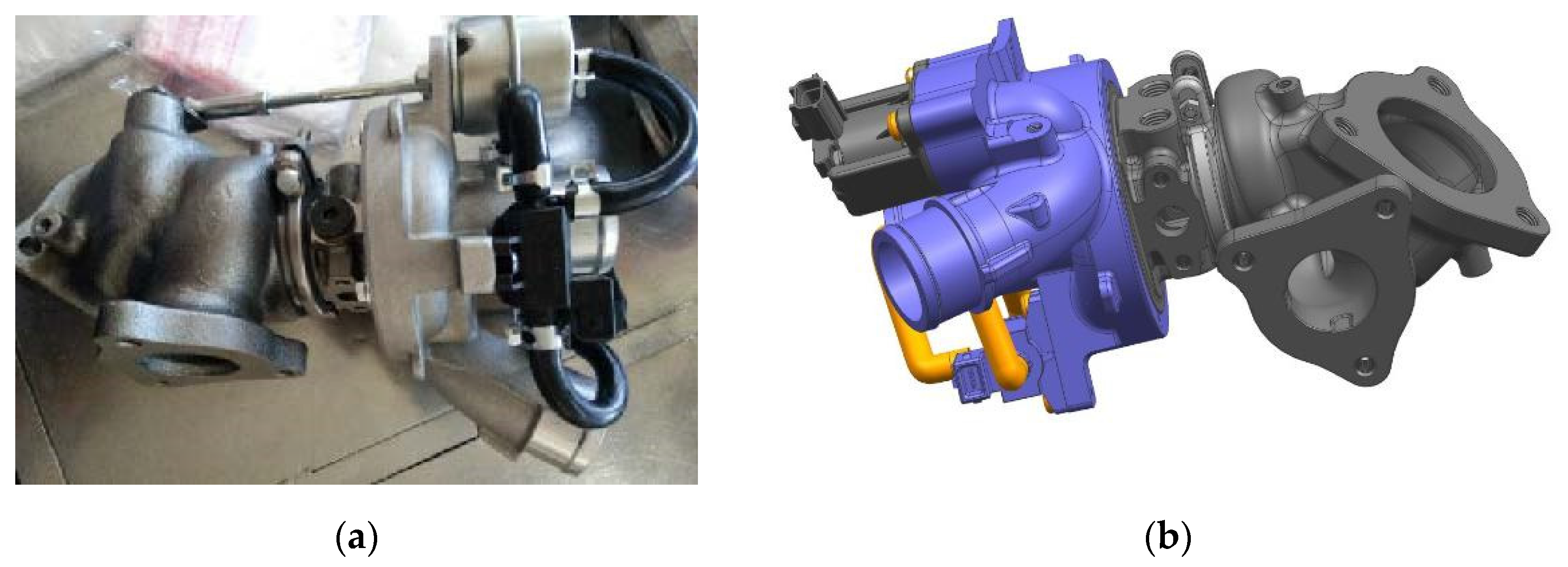
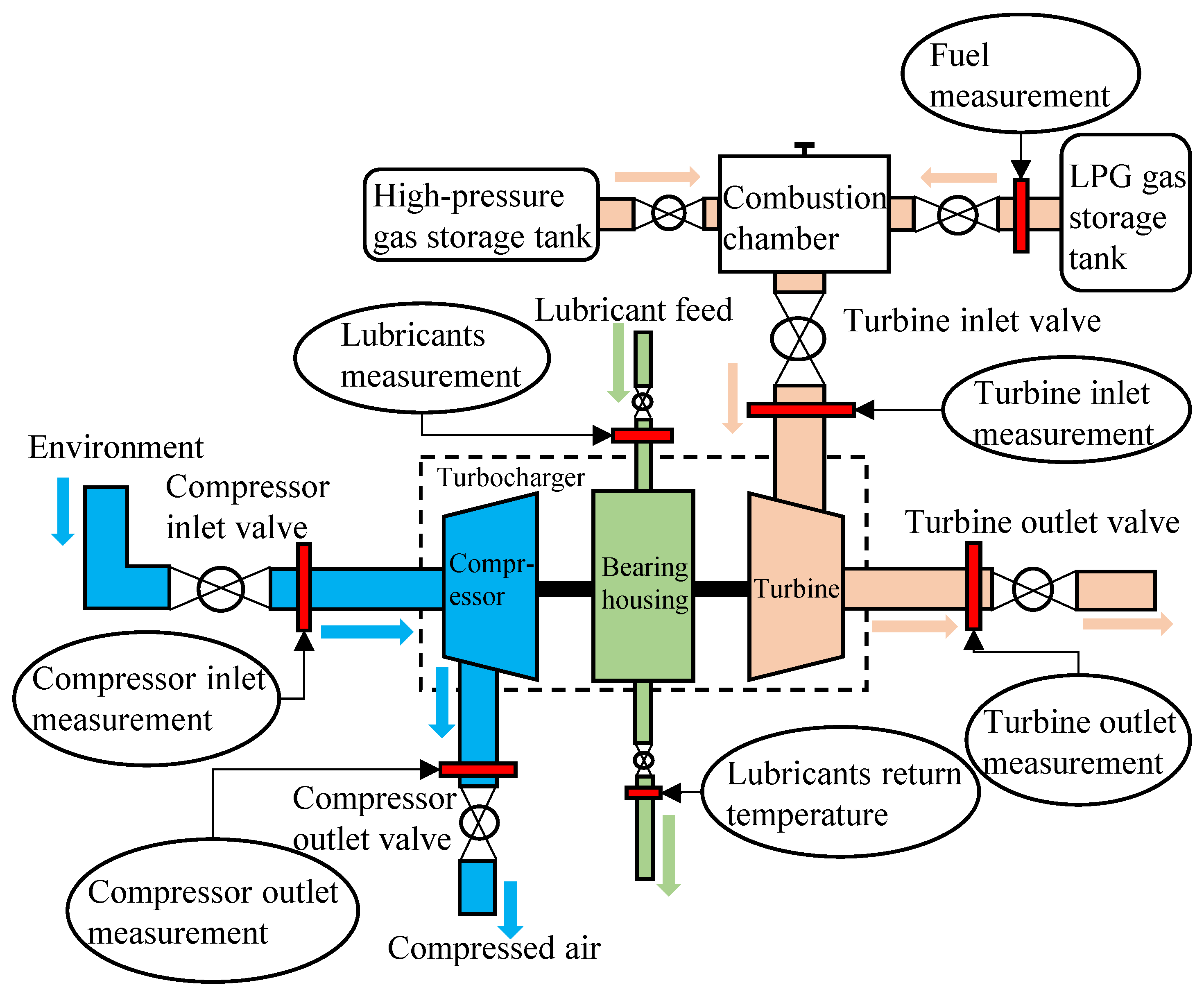
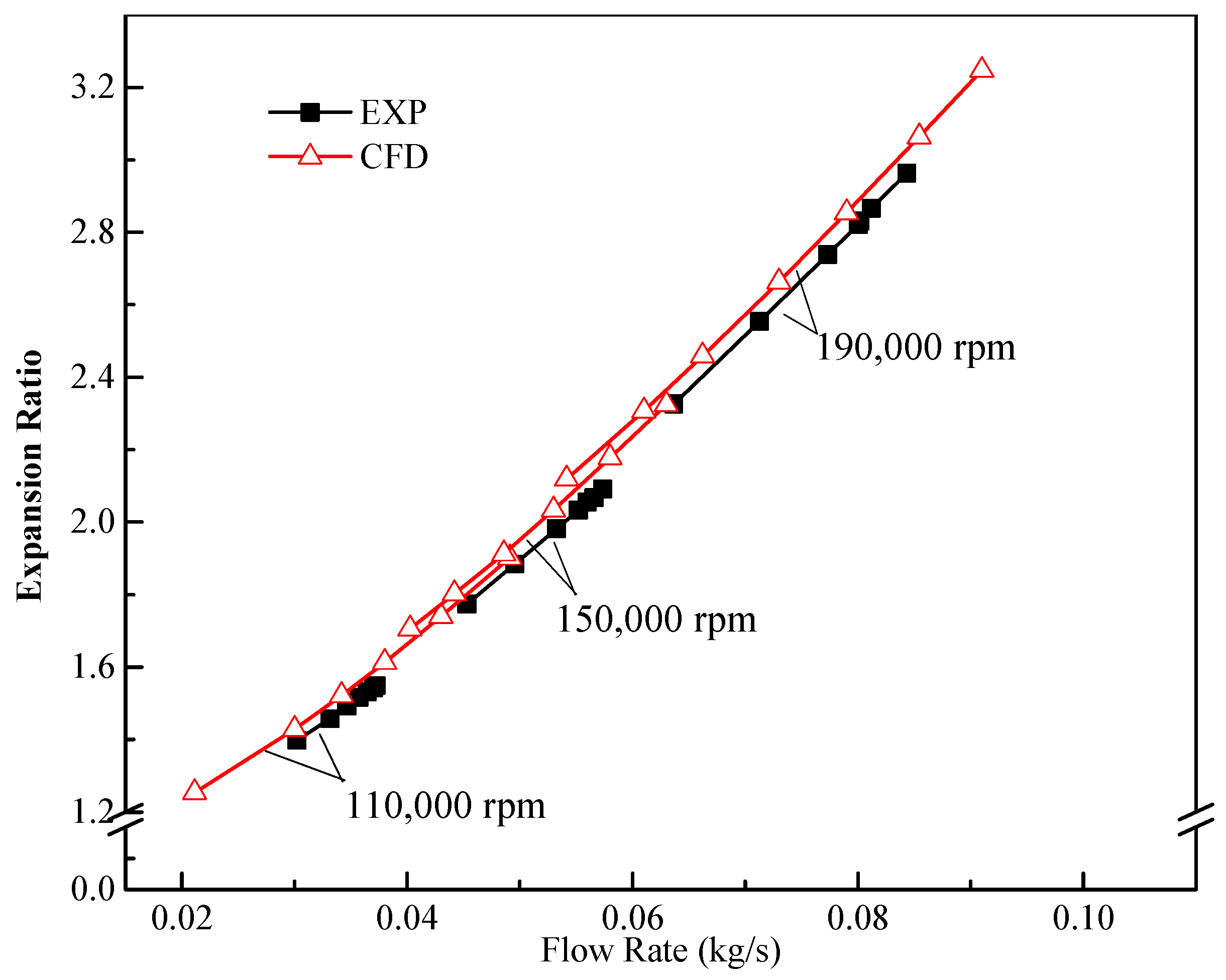
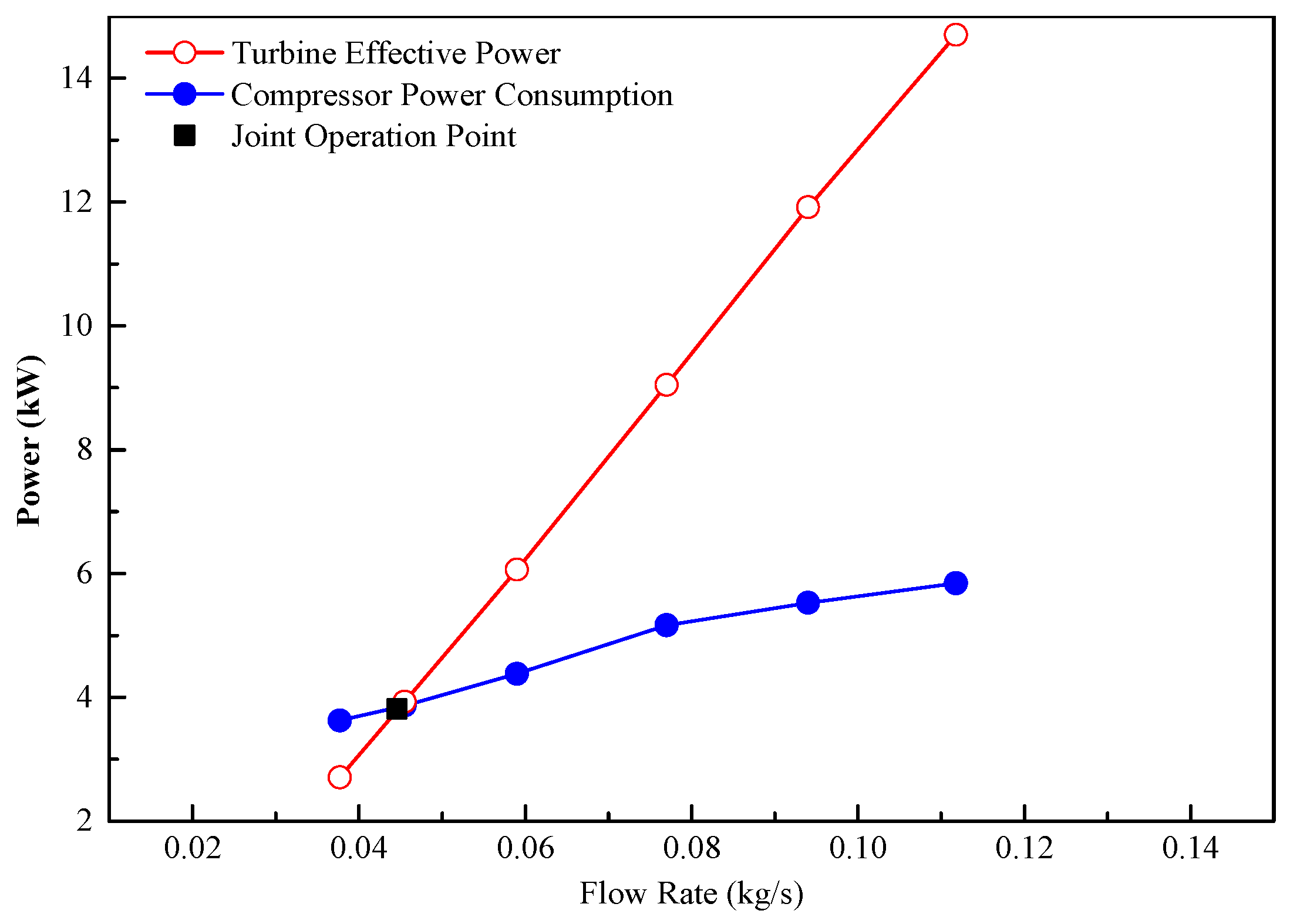
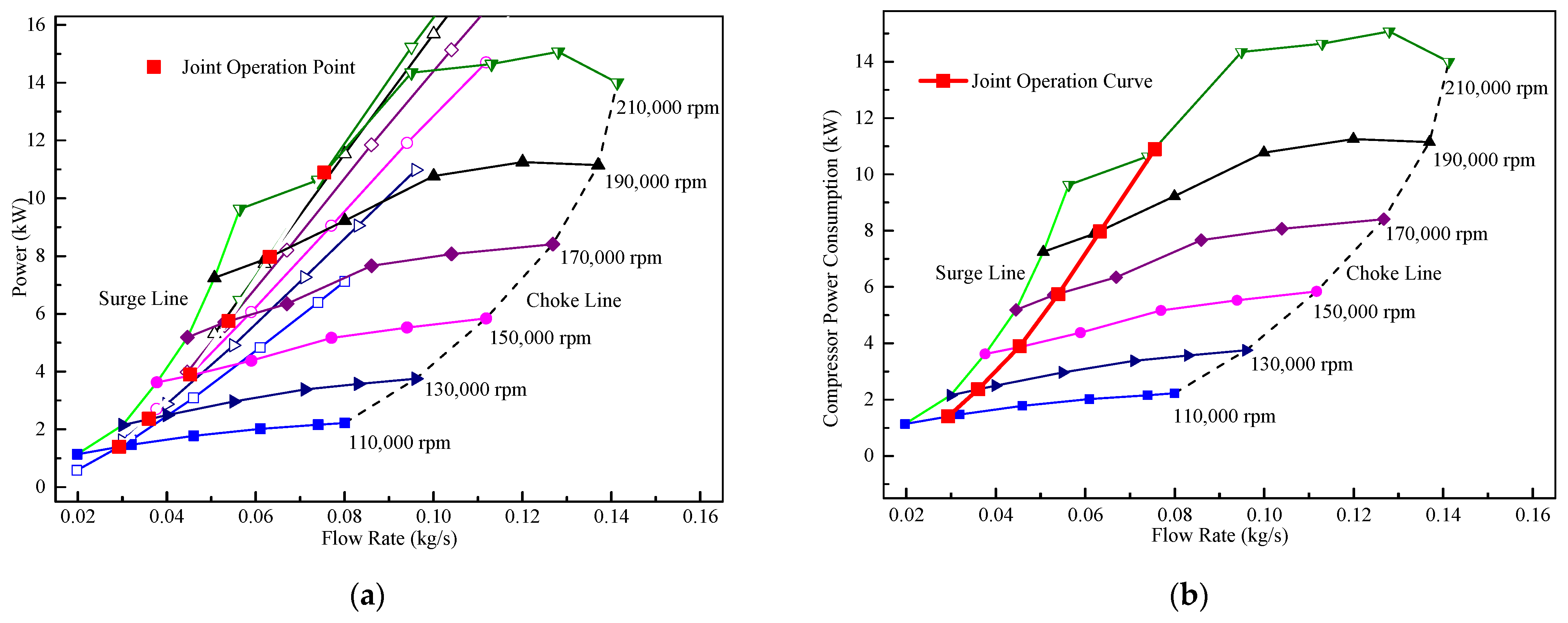
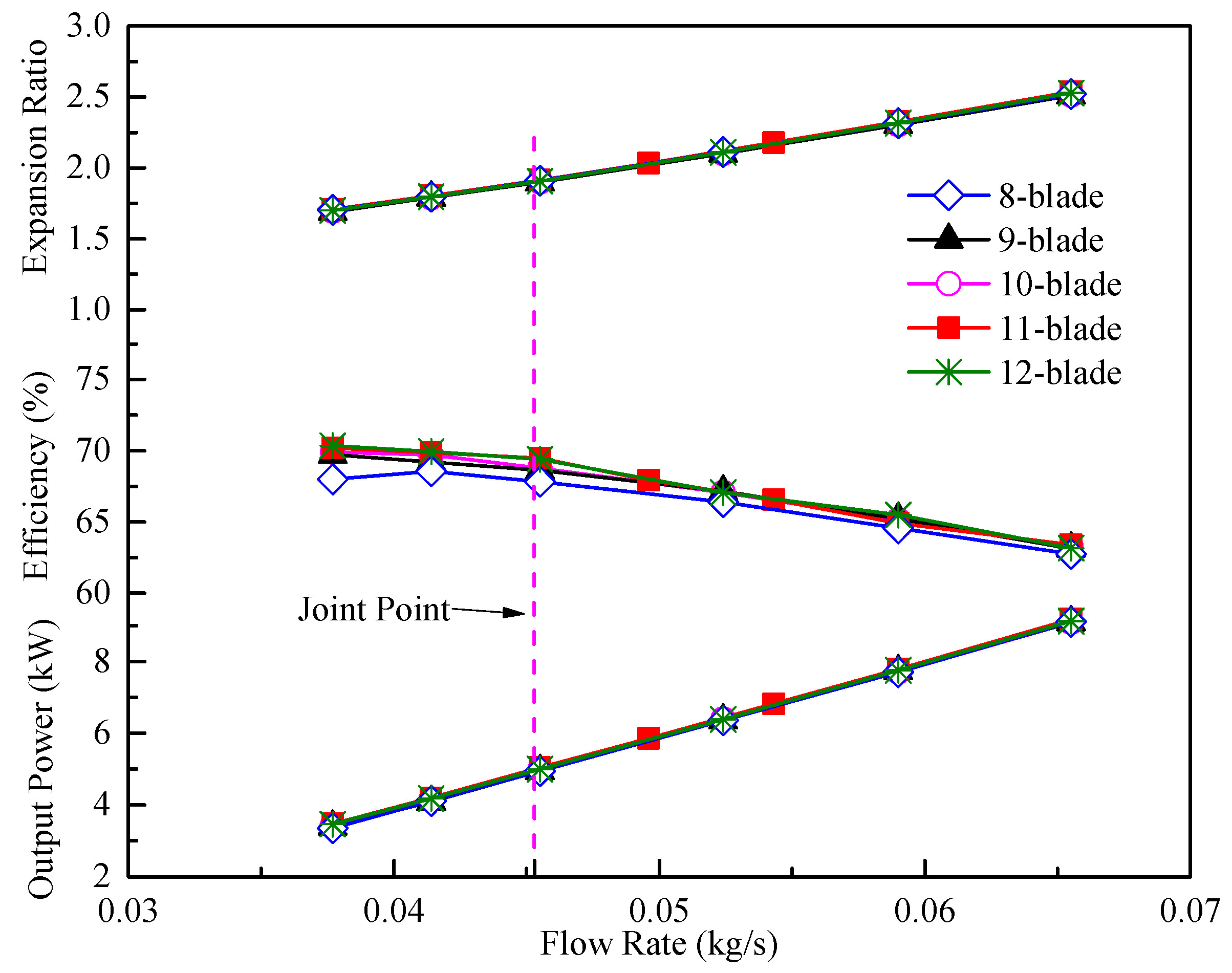
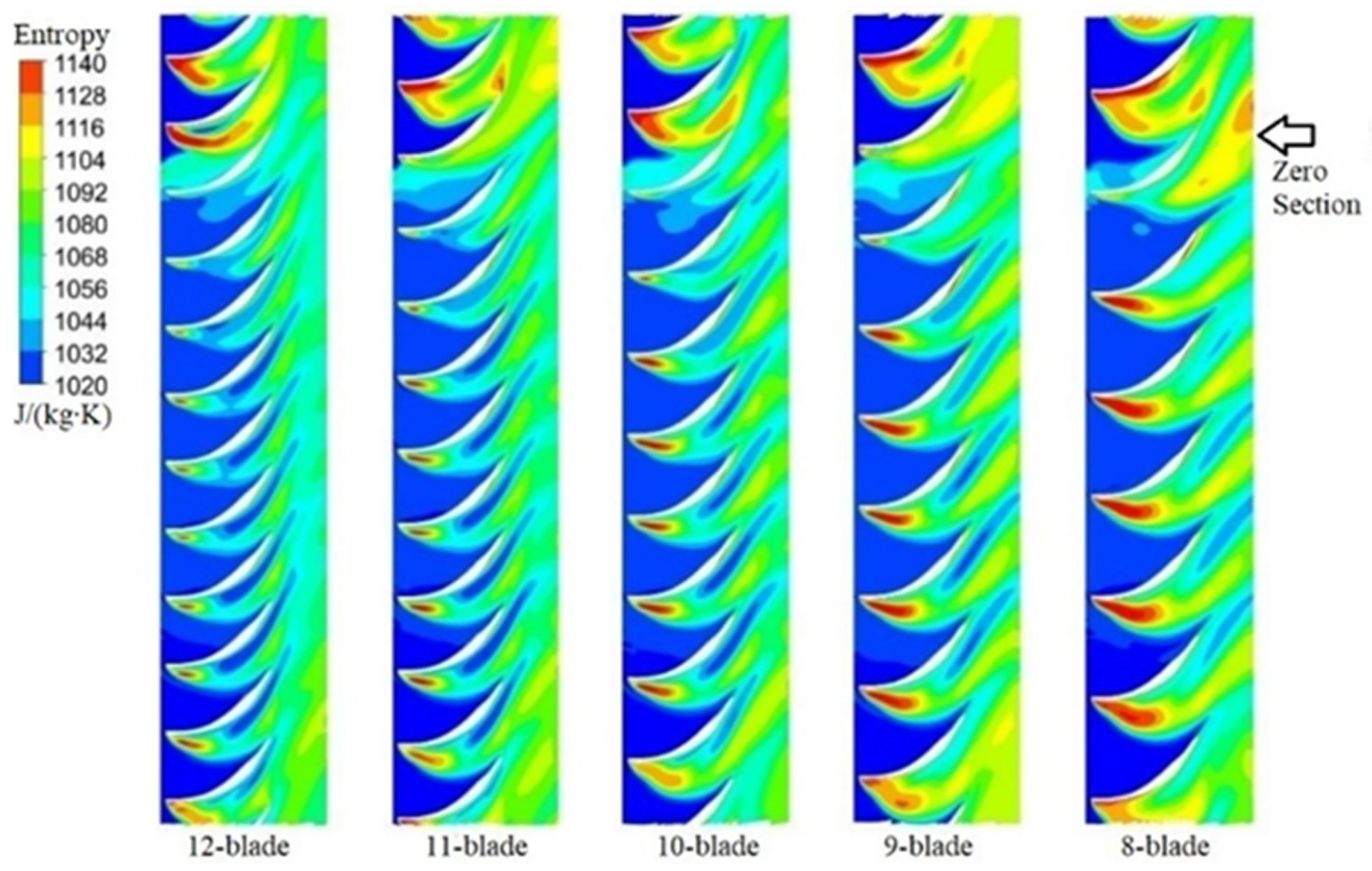
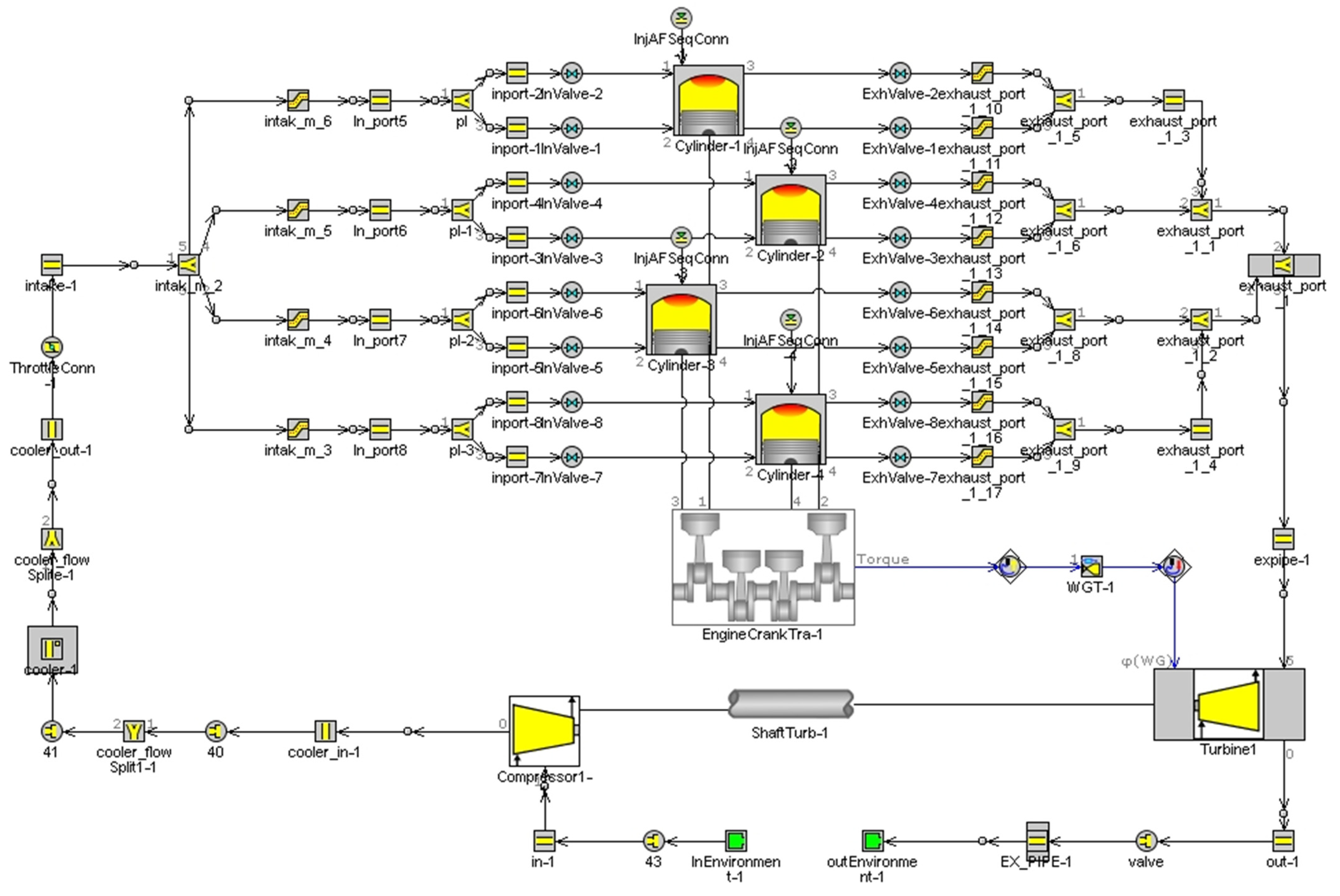
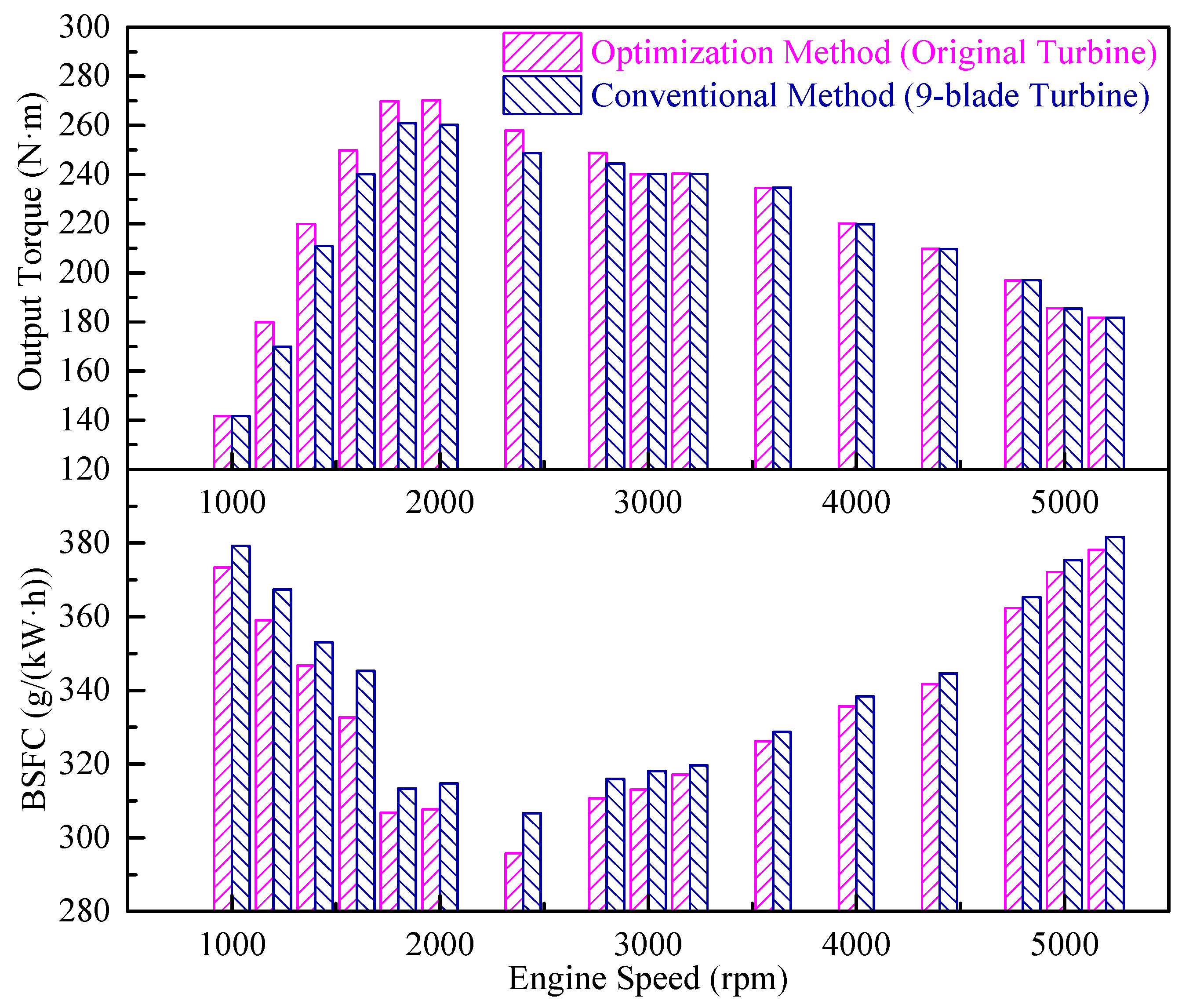

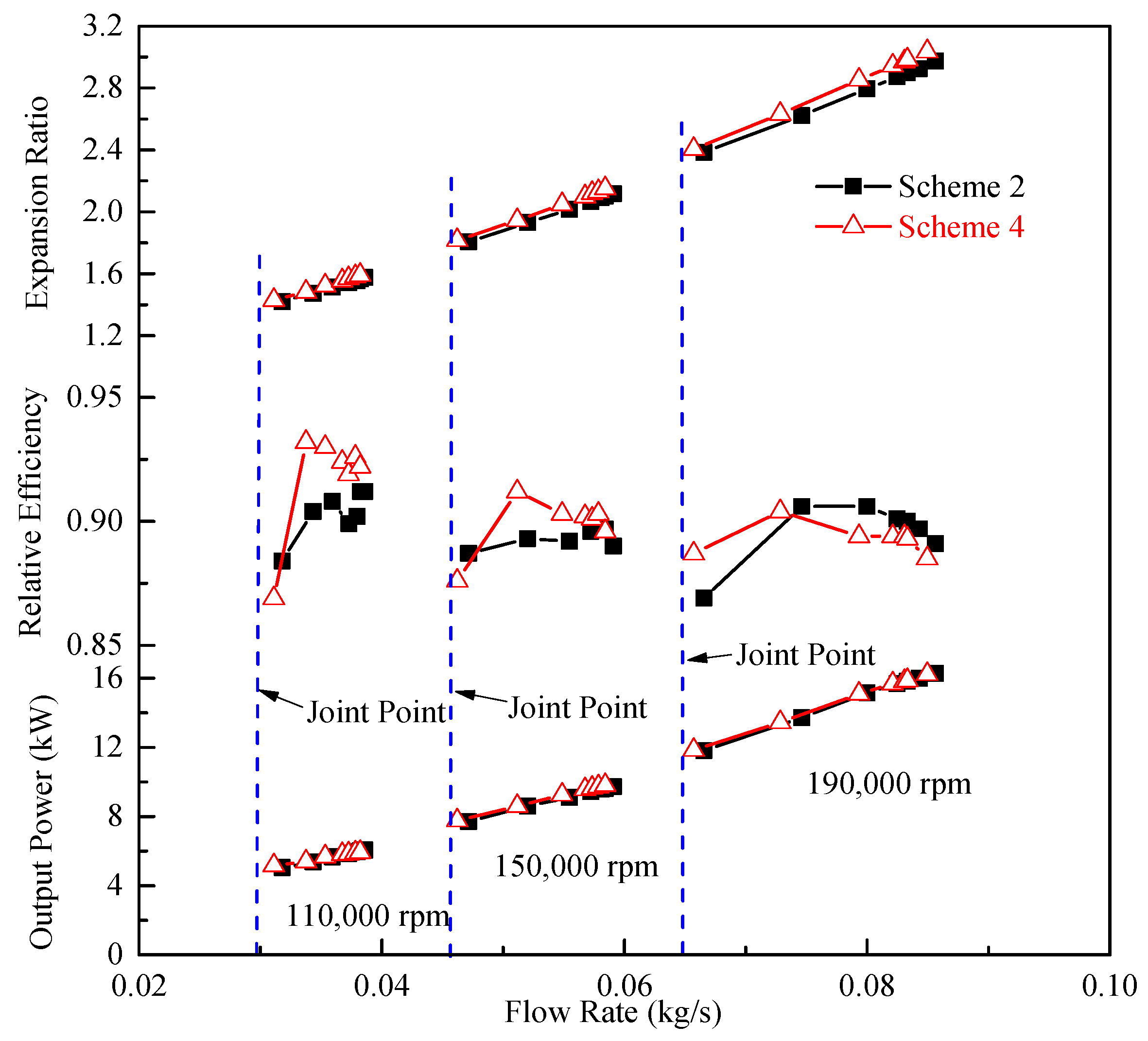
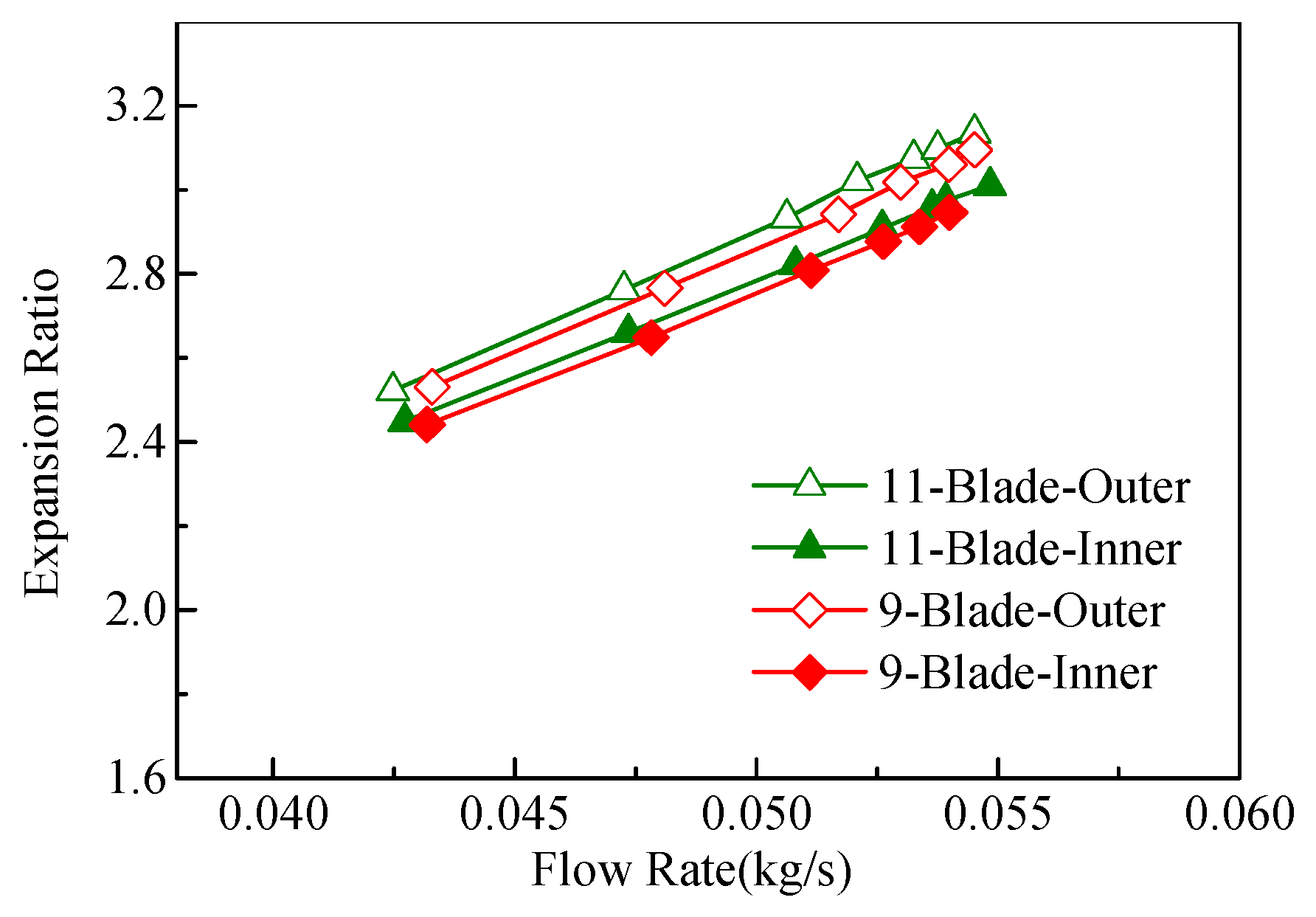

| Scheme | Volute Structure | Impeller Blades |
|---|---|---|
| 1 (Original Turbine) | Single-entry | 11-blade |
| 2 | Twin-entry | 11-blade |
| 3 | Single-entry | 9-blade |
| 4 | Twin-entry | 9-blade |
| No. | Parameter | Profile |
|---|---|---|
| 1 | Volute inlet diameter/mm | 36.0 |
| 2 | Volute nozzle width/mm | 5.0 |
| 3 | Impeller inlet diameter/mm | 37.6 |
| 4 | Impeller outlet diameter/mm | 33.1 |
| 5 | Impeller axial length/mm | 18.9 |
| 6 | Impeller inlet blade height/mm | 5.1 |
| 7 | Impeller inlet blade angle/deg | 0 |
| 8 | Impeller exit mean blade angle/deg | 56.4 |
| 9 | Radial and axial tip clearance/mm | 0.5 |
| 10 | Number of blades | 11 |
| 11 | Flow range/(kg/s) | 0.02–0.13 |
| Fluid Domain | Mesh Type | Mesh Numbers |
|---|---|---|
| Inlet duct | Structured | 73,219 |
| Separate turbine volute | Unstructured | 620,189 |
| Impeller single blade channel | Structured | 203,038 |
| Wheel back clearance | Unstructured | 242,283 |
| Outlet transition | Unstructured | 527,878 |
| Outlet duct | Structured | 169,575 |
| Total | 3,866,562 |
| Joint Point Performance Parameters | Output Power | Expansion Ratio | Efficiency |
|---|---|---|---|
| Weight assignment | 60 | 30 | 10 |
| Number of Blades | 8 | 9 | 10 | 11 |
|---|---|---|---|---|
| Joint point output power (kW) | 3.58 | 3.60 | 3.62 | 3.63 |
| Joint point expansion ratio | 1.72 | 1.71 | 1.71 | 1.72 |
| Joint point efficiency (%) | 66.14 | 67.3 | 67.25 | 67.61 |
| Turbine Performance Index | 98.9 | 99.7 | 99.9 | 100.0 |
| Number of Blades | 8 | 9 | 10 | 11 | 12 |
|---|---|---|---|---|---|
| Outlet Absolute Speed (m/s) | 201.42 | 196.87 | 190.68 | 190.50 | 190.11 |
| Turbine State | Scheme 1 | 11-Blade-Outer | 11-Blade-Inner | 9-Blade-Outer | 9-Blade-Inner |
|---|---|---|---|---|---|
| Joint point output power (kW) | 8.08 | 10.07 | 10.03 | 10.07 | 10.07 |
| Joint point expansion ratio | 2.41 | 3.94 | 3.96 | 3.95 | 3.98 |
| Joint point efficiency (%) | 62.59 | 53.65 | 52.54 | 53.79 | 52.23 |
| Turbine Performance Index | 100 | 101.6 | 101.1 | 101.7 | 101.3 |
Publisher’s Note: MDPI stays neutral with regard to jurisdictional claims in published maps and institutional affiliations. |
© 2022 by the authors. Licensee MDPI, Basel, Switzerland. This article is an open access article distributed under the terms and conditions of the Creative Commons Attribution (CC BY) license (https://creativecommons.org/licenses/by/4.0/).
Share and Cite
Yin, S.; Ni, J.; Fan, H.; Shi, X.; Huang, R. A Study of Evaluation Method for Turbocharger Turbine Based on Joint Operation Curve. Sustainability 2022, 14, 9952. https://doi.org/10.3390/su14169952
Yin S, Ni J, Fan H, Shi X, Huang R. A Study of Evaluation Method for Turbocharger Turbine Based on Joint Operation Curve. Sustainability. 2022; 14(16):9952. https://doi.org/10.3390/su14169952
Chicago/Turabian StyleYin, Sheng, Jimin Ni, Houchuan Fan, Xiuyong Shi, and Rong Huang. 2022. "A Study of Evaluation Method for Turbocharger Turbine Based on Joint Operation Curve" Sustainability 14, no. 16: 9952. https://doi.org/10.3390/su14169952
APA StyleYin, S., Ni, J., Fan, H., Shi, X., & Huang, R. (2022). A Study of Evaluation Method for Turbocharger Turbine Based on Joint Operation Curve. Sustainability, 14(16), 9952. https://doi.org/10.3390/su14169952






